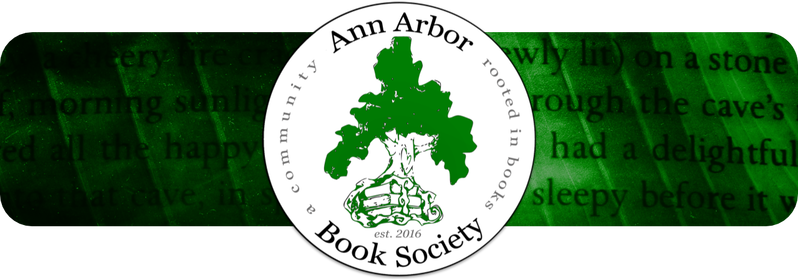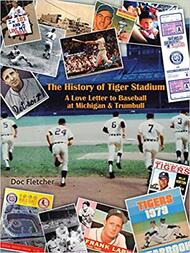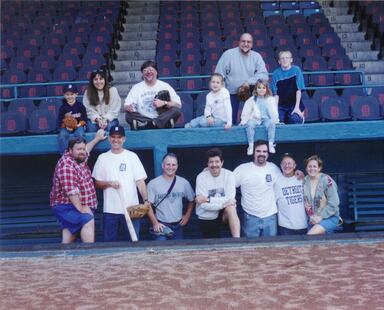An Interview with Doc Fletcher, Author of The History of Tiger Stadium: A Love Letter to Baseball at Michigan & Trumball
Doc Fletcher celebrates his life lived in Michigan by writing books that honor the state. He has written nine books about kayaking and canoeing Michigan rivers. His new book, “The History of Tiger Stadium: A Love Letter to Baseball at Michigan & Trumbull” is now available online, at a book signing, or by check in the mail.
Lake Roberts: Let’s just jump in, this book is such a departure from the other kinds of books that you’ve been writing.
Doc Fletcher: I really had no intention of writing a book about Tigers Stadium, about the Tigers, as much as I’m passionate about them. This wasn’t obvious to me at the time but I think what prompted me to write it was that a month before, one of my favorite Detroit Tigers of all time- a pitcher named Frank Lary- passed away. He was known as the Yankee killer. And as much as I love the Tigers, I probably despise the New York Yankees. I had the good fortune of meeting Lary during his retirement at a VFW Hall in Redford, in 2007. He was signing autographs so I stood in line and shook his hand holding this black hat with white letters I had purchased outside of Fenway park- it said, “Yankees Suck.” He laughed and signed my hat. I asked him if he would write his all-time record against the Yankees and he asked me what it was: 28-13.
After he passed away in December 2017, my wife Maggie and I sent a condolence card to his wife Mary Catherine. We had never met her, just looked up her address and very surprisingly, she wrote me back. That card began a correspondence between the two of us that led to phone calls and she ended up contributing some wonderful stories about her husband as well as photos for me to use in the book.
It’s been a 15-month journey writing the book, doing the research, pouring through bookstores, decade after decade, as only somebody half crazy about their Tigers would do. It finally came to fruition and I was able to submit the book for publication and I had my copies in May. Over Memorial Day my wife, Maggie, and I hand-delivered a copy to Mary Catherine where she lives on baseball drive outside Tuscaloosa Alabama. We went out to lunch and had a delightful two and a half hour conversation. It was one of the most enjoyable moments of this whole experience.
LR: Where does your love for the Tigers come from?
DF: I’ve lived my whole life in Michigan, always in the Detroit or the Greater Detroit area. I lived in the city from birth until I was twelve, and then we moved down to a tiny town in Southern Michigan called Lambertville. Then I went to school at Eastern Michigan. So, yeah, I’ve always had a very strong passion for the Tigers.
My father was a huge Lions fan. He grew up when Bobby Lane was king in the 1950s and to him, baseball was just two guys playing catch. But my father knew how much I loved the Tigers and those damn Yankees and Mickey Mantle were coming into town, so he took me to my first game at ten years old. It was 1965. And, it was one of the most amazing experiences of my life. I’m getting goosebumps just talking about it right now. To see that incredibly green, green grass, the smell of the peanuts and the cries of the vendors- there was a five-man Dixieland band that would perform before the games in those days with their red and white striped shirts- and the players playing a little pepper on the sidelines. Bill Freehan was entertaining the fans by catching the ball behind his back. That first game was the basis of the preface of the book. I love to read it and think about that, and think about my father. It was a great experience.
LR: I have a memory of attending one of the last three games at old Tigers Stadium- I was 10 years old in 1999 and my mother told me to go scoop up a little dirt and save it in a jar, and I still have it. How did you feel researching this special place that is no longer there?
DF: My own personal feelings and the feelings of many people when Tigers Stadium came down could be summed up in the sign that was hanging on the final game ever played there on September 27, 1999. “Today there is crying in baseball.” It was the memories of going with our parents, our grandparents, our aunts, our uncles, our godparents. And as beautiful as Comerica park is, and I know there will be a whole new generation of kids who will have their own memories of Comerica, Tigers Stadium was special to me and I think more beautiful than any stadium I’d ever been to in my life. So it was a very sad moment when the stadium came down.
It took ten years from the last game until the stadium was finally leveled, which happened in 2009. But we would still go down there and hang around. My friend passed away in 2006, so we spread his ashes around the outside of Tigers Stadium. It meant an awful lot to us. Even in 2012, when the Detroit Tigers beat the Yankees to go to the World Series, I left Comerica park early and caught a ride down to Michigan and Trumbull and even though it was just an empty field I stood at the edge and smoked a victory cigar. I thought about all the wonderful times. I’m getting goosebumps again. All the wonderful times and moments I had at Tigers Stadium, it means a lot to me and I’m not alone in that.
I attended every opening day at Tigers Stadium from 1975- 1999, with one exception. I did not go to the 1995 opener because the players had gone on strike, and for the first time in the lives of anybody living in the United States, there was no World Series. I was so frustrated with a group of rich owners and rich athletes that couldn’t find a way to divvy up the huge pot of money they had. I wrote the Tigers a letter about my frustration- and Maggie and I took the 40-50 people we would’ve taken to opening day and went down to the Toledo Mud Hens; minor league baseball. ‘95 was my one year where I had to say, ‘Not this year.’
But I went to so many games and I’m blessed with a very good memory so a lot of the book was first-hand. Plus, not only my personal visits but I talked with my friends and their parents.
I interviewed one lady, Ella, who is now 94 years old. As a ten year old girl in the summer of 1935 (when the Tigers won their first world series, by the way), she lived just a short distance from what was then called “Navin Field.” Every Thursday was Ladies Day, and women could get in for 50 cent tickets and bring as many kids as they wanted. So Ella said she’d be one of six or eight kids who would go down before the game started so they could watch batting and fielding practice. The Ladies Day seats were in left field and the Detroit Tigers left fielder was a guy nicknamed “Goose.” He was Leon Goslin but everybody called him Goose because of the way he sauntered about. He had a nose that kind of reminded you of a goose. Ella can remember when balls were hit to Goose Gosling during practice she and all her friends would yell, “Goosey Goosey Goosey!” and he would turn around and throw them a baseball.
There are already some fine books about Tigers Stadium, so in trying to differentiate myself I talk not only about the players and the ballyard, but the characters in the stands, the characters who worked the concessions, the characters in the nearby neighborhood who own taverns, that type of thing.
LR: The site of old Tigers Stadium is practically hallowed. Maybe that comes from just how long it was standing and all the changes Detroit went through?
DF: Its funny that you should use the word hallowed. I just typed it in today. This is a topic that, despite the very difficult year the Tigers are having in 2019, there is a lifelong passion for them. And it’s the 20 year anniversary of the final game ever played in Tigers Stadium. And, this is the 35 year anniversary of the 1984 team. Kind of funny, 2019 seems like a good year for Tiger fans to live in the past.
LR: How much time do you spend writing and how do you decide when it’s time to go out and talk to people about the book?
DF: As far as the amount of hours I’ve put in, I had a thirty year career in the corporate world. Fresh out of college in 1976 through 2006 I worked for Duracell battery company. A wonderful experience– very ethical business. I left them at the end of September in ’06 and from that point on the amount of hours I wanted to put into writing was as many as there are hours in the day. Many writers have a full-time job and I imagine that’s very difficult for them.
LR: Did you write while you were working?
DF: No. I wasn’t writing books, but I would make presentations about Duracell batteries and different promotional opportunities. So far as being able to explain myself and organize my thoughts I had a nice background. I wasn’t really planning on writing more than one book when I started. I thought, “What I’m going to do is write this book about paddling Michigan rivers. I love Michigan, I’m thankful that I’ve lived my whole life here. I’d like to do something to honor the state.”
And I picked a number, “20 rivers, that’ll be good.” And because a river trip to me also involves learning the area that I’m paddling through and finding a great bar to get a burger in afterwards I subtitled the books: The Rivers, the Towns, The Taverns.
For my first book I researched during the winter months from 2006-2007, I had my river schedule from April-August, and then I wrote the manuscript. I researched publishers that might be interested; Michigan-based publishers for Michigan-based rivers. In October of ’07 I wrote the first one. “Here’s what the idea of my book is about, would you be interested in publishing such a book?” I sent it out and was typing to the second of the eleven publishers. Ten minutes later, I had a response from the first one. “Doc, this sound like something we’d love to publish.”
Even if that was it, even if they looked at it and weren’t interested, I was excited. I ran downstairs and told Maggie, “It’s pizza night!” After a week I was getting a little nervous and hadn’t heard from them so I called and they said, “Doc we’re sitting here going over your book right now, great timing. We’d like to offer you a contract.” I silently did a dance in my chair while I calmly said, “That sounds great.”
After the first book came out my publisher said, “You know libraries like to have Michigan-based publishers come in and share their stories. I started doing libraries and I started working on a second book and the ball kept rolling. My thought was that I’d do one book and then I’d see if I could work part- time at Michigan.org; anything to promote the state of Michigan would be fantastic. I also looked at working for the Detroit Tigers, anywhere from working in the stands to working in the marketing department.
One book became two became three. On this most recent book it took me 15 months from when I started making my scribbles- the first 14 of those months I averaged 2-3 hours/day. Sometimes it was 8-10 hours, sometimes I was gone from the house for a weekend and there was zero. So I have the luxury–the very long answer to your question–I have the luxury of being a retiree and I don’t have to make money on these to support myself. I’ve already done that through 30 years of corporate work.
LR: I’ve only got one more question, and it’s “Do you have a favorite bookstore in Ann Arbor?”
DF: Let’s see. I live in Northville so I usually go to Little Paris. But there’s one at Westgate shopping Center that I think is a pretty cool store.
LR: Nicola’s?
DF: Yeah, that’s it.
LR: Well thank you so much for taking the to talk to me. And giving such interesting and thorough responses.
DR: You’re very welcome. I’m glad I could be of help.
Doc is front row center; his wife Maggie is second from the left in the back row.



